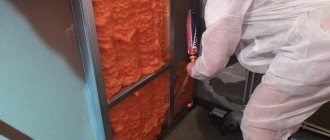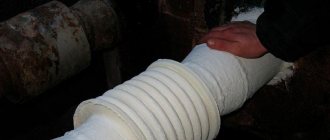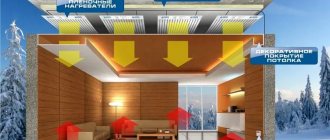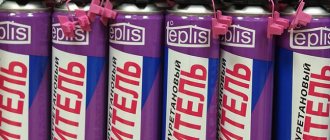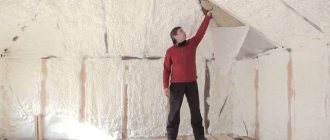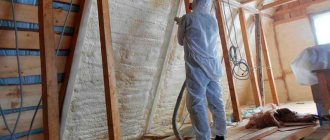Possibility of using foam fillers
Balloon thermal insulation , although better than its analogues in all respects, was not widely used in the past due to its high cost. And the use of such insulation was limited by the need to use special equipment, which, due to its price and complexity of development, is practically inaccessible outside the professional sphere. Much simpler and more profitable, although not always more convenient, was the use of mineral wool and polystyrene boards, which are made by extrusion.
Then manufacturers began to produce sprayed insulation in compact-sized cylinders, which led to a reduction in the cost of the method. To spray such a mixture of steel, complex installations and specialists in thermal insulation finishing are not needed, since the material itself is filled into small containers and the possibility of manual spraying is provided. Each cylinder is designed to cover one square meter of base (layer up to 60 mm thick). One person can process up to one hundred square meters per day.
As a result, calculations showed that working with insulation such as Polyno
r is much more profitable in terms of labor costs , costs for the materials themselves and surface preparation.
If a professional team of workers charges up to one and a half thousand rubles for insulating one square of wall, then using Polinor insulation with the same amount of material, you need to spend only about 500 rubles. You can work independently, which eliminates the need to look for experienced workers, reduces finishing time, and saves money. The choice of thermal insulation of this type remains the only optimal option that is available to people without special training. Foam can be used to create insulation for foundations, basements, walls inside and outside buildings made of brick, stone, concrete, and blocks. This option is also suitable for thermal insulation of non-load-bearing coatings, including floors on joists, as well as pitched roofs and attic floors.
Since Polinor is suitable for application to bases made of almost any material, it can be used as thermal insulation for plumbing fixtures and sewer pipes or fittings. In such cases, foam insulation in cylinders can be used indoors or in open areas. There is only one limitation on the use of balloon thermal insulation, which is that the material cannot be used to foam voids. It can only be applied to a dense base.
Polyurethane foam
From a technical point of view, everything will be much simpler here. The composition will be mixed from two ready-made components and the whole process will be much easier. It is necessary to observe the proportions of liquid compositions entering the mixer and monitor the pressure provided by the compressor
The rest of the precautions will be the same as in the previous case - you can easily destroy fragile brickwork with foam, which can expand forty times
The cost of the material in this case will be higher, but it is easier to work with and the quality of the insulation will be at a high level
It is important to ensure that the voids are filled evenly. At the same time, during the polymerization process, this composition will release significantly less formaldehyde compounds than in the situation with penoizol, and the time for complete hardening of the foam will be reduced several times
Regardless of the chosen option for foam insulation, you need to remember that there are no harmless compounds of this kind. All of them will release formaldehyde during the polymerization process. Therefore, while the foam dries, it is better to leave the house empty and not live in it. It will take a couple of days or even a week, but you are guaranteed to protect yourself and your loved ones from poisoning. In this regard, penoizol performs worst of all, which can dry in open spaces for up to thirty days - depending on the proportions of mixing the components and the quality of the raw materials.
Material characteristics
Polyurethane foam (PPU) looks like a homogeneous structure of foam material, consisting of air bubbles filled with gas. Various versions of polyurethane foam are deservedly popular because they can be manufactured directly on the construction site. The most common method is to apply the material to the surface by spraying. Spraying is used for thermal insulation of houses, industrial workshops, pipelines, and in addition, it is actively used in the interior of premises.
Filling is used when it is necessary to fill a cavity between walls or a gap between installed finishing layers.
The thermal conductivity coefficient of the material is 0.023-0.025 W/mS. Teplis heat insulator is lightweight and can be easily applied to surfaces made of any materials (concrete, brick, glass, wood, aluminum, PVC).
Thanks to the optimal ratio of open and closed cells in the structure, the insulation “breathes”. Accordingly, the treated surface always remains clean and dry.
Other product benefits include:
- resistance to temperature changes;
- environmental friendliness;
- duration of operation (at least 20 years);
- seamless application, eliminating the formation of cold bridges;
- good sound insulation;
- low flammability;
- immunity from harmful rodents and insects.
Teplis polyurethane insulation is sold in 1 liter cylinders. Included with this product, the manufacturer offers to purchase a mounting gun with nozzles for uniform spraying.
Basement of a house with sprayed insulation applied
Sputtering process
If you have entered into an agreement with a company, a minibus arrives at the appointed time. It contains spraying equipment. To operate a high-pressure apparatus, a voltage of 380 V is required. If you only have 220 V, you usually start a generator that produces the required voltage. A low-pressure apparatus can operate from a 220 V network, but, as discussed below, the quality of thermal insulation will be significantly worse.
Typically, only hoses are pulled into or around the house to supply the foam components to the gun. It's comfortable. Workers who spray thermal insulation are dressed in protective suits, wearing a respirator, gloves and goggles. A respirator is necessary, since before hardening the components of the foam are toxic, and everything else is to protect the skin from ingress of polyurethane foam, which then cannot be removed.
The foam is applied from bottom to top, in small portions. Fill everything in without skipping, trying to prevent the formation of shells. As the foam expands, make sure that the layer thickness is no less than the required one. After the foam hardens, the excess can be cut off, but the deficiency cannot be made up for.
Description and characteristics
Polinor is produced in a liquid state and applied to the surface by spraying. This popularity of the material is not caused by chance, because it is characterized by the following advantages:
- Fast drying. The surface becomes hard after 1 hour.
- Unaffected by rodents and insects.
- Does not form cold bridges.
- Does not harm the human body.
- There is no need to buy expensive equipment for application.
- The material is characterized by high efficiency.
- Has a long service life.
- The structure of the material is closed cells that do not allow water or steam to pass through.
- The material is self-extinguishing if there is no direct influence of fire.
In the photo - liquid insulation in cylinders Polinor
Polinor is not without its disadvantages, which include:
- A surface made of Polinor is resistant to direct influence of UV rays and constant contact with water, and the process of applying the material must take place at a temperature of 15-25 degrees.
- When working with insulation, you must adhere to safety rules using a mask and respirator.
Compared to existing analogues of liquid thermal insulation for walls, Polinor insulation is significantly different. First of all, the changes concern the structure, or more precisely, the percentage of open and closed cells in the solid mass. This criterion is very important, as it affects the level of thermal conductivity, moisture absorption and water permeability. Using Polinor, you can get about 70% of the cells, while when using similar sprayed products, the number of closed-type cells will be only 30-40%. However, it cannot be used as a seal for interior doors.
On the video, liquid insulation in cylinders Polinor:
The material in question has the lowest thermal conductivity among all the insulation materials that are available on the domestic market today. For example, mineral wool has a thermal conductivity coefficient of 0.045, expanded polystyrene – 0.033, and Polinor – 0.023 W/m2* °C. Thanks to these properties of the heat insulator, it is possible to reduce its consumption. One cylinder will be enough to treat 1.2-2.0 m2.
Sprayed thermal insulator Polinor can be applied at temperatures from -25 to +125 °C. If it is exposed to a temperature of 450 degrees, then its length will be deformed by 85%, and damage by weight will be 50%. The duration of its independent combustion will be 5 minutes.
Polinor is an environmentally friendly insulation material, thanks to which it can be used when arranging a residential building. The material has high adhesive properties to various surfaces, resistance to moisture, chemicals and aggressive environments.
wall pie
Construction of a wall “pie” of a frame house:
- interior decoration;
- vapor barrier layer;
- insulation;
- frame stand;
- windproof layer;
- transverse lathing;
- vertical lathing;
- external finishing.
wall pie
If you plan to insulate the premises from the inside, you need to carry out all the work in stages. One of the main issues that you should pay special attention to is the correct placement of the vapor barrier film in the thermal insulation “pie”.
Vapor barrier can be made from:
- reflective film;
- diffusion membrane;
- steam condensate film.
When installing a vapor barrier material, you need to take into account one important point: it must be mounted on top of the insulation on the room side. If you plan to insulate the wall with polyurethane foam, then you will not need a vapor barrier.
Liquid foam
This type of insulation includes almost all foam materials based on polymer resins. The quality of the final product, including its environmental friendliness, largely depends on them. There are raw materials whose use is not permissible for residential premises due to the high toxicity of the polymer and its long-term emissions. At the same time, such materials are quite suitable for insulating technical structures or isolated building elements (if there is confidence in their insulation and the conscientiousness of the working specialists).
At the moment, such types of liquid foam as polyurethane foam, penoizol, as well as a number of products in compact cylinders are common.
Polyurethane foam (PPU)
Viscous heterochain polymers in a liquid state are used as the main component of this insulation. During chemical reactions, urethanes foam, which leads to their increase in volume by more than 50 times.
In its frozen state, polyurethane foam resembles ordinary polyurethane foam, the main difference in the structure is less porosity.
Mainly used for:
- Insulation of walls of frame buildings;
- Roofing structures;
- House facades;
- Thermal insulation of basements and lower floors.
To apply polyurethane foam, you need a special unit that first mixes and foams the insulation components, and then delivers the finished mixture under pressure to the surface to be treated.
Final polymerization occurs within 24 hours, after which the finishing can be installed. Polyurethane foam is suitable for treating surfaces made of brick, concrete, wood, metal, cinder blocks and gas silicate blocks.
The average cost of work including material is 1000-1500 rubles per m2 , with a layer thickness of 50 mm.
Penoizol
A budget analogue of polyurethane foam insulation, since it is based on relatively cheap, but more toxic urea-formaldehyde resin. The structure of this insulation is very similar to ordinary foam plastic, but its use is more preferable due to the absence of cold gaps in the insulating layer, characteristic of sheet and roll materials.
The density of penoizol, even in a liquid state, is noticeably lower than its urethane analogues, which does not allow its use in loaded structures. Otherwise, the scope of application is similar to polyurethane foam. Thermal insulation qualities are also not exceptional and are comparable to mineral wool, and two times less than that of the polyurethane foam described above.
Apply under pressure after pre-mixing the components and foaming. Increases in volume by no more than 30 times relative to the original mixture.
Roof insulation with foam insulation
Work together with the material costs approximately 2000 rubles per 1 cubic meter .
Polyurethane foam
The products are mainly used for processing seams between insulation elements. Polyurethane foam is relevant as a means for sealing structures; it is also used for fastening building and finishing materials to the base being constructed. In terms of operational characteristics, the resource has an average level of efficiency. Do-it-yourself polyurethane foam for insulating the walls of a house is produced in small containers; the products are presented in a wide variety of models. When applied, the composition expands 20 times. The material is easy to use independently; even an amateur can handle the job.
Polyurethane foam
Building materials in this category are attractive due to their versatility. Polyurethane foam as thermal insulation demonstrates a high level of efficiency. The PU foam composition has excellent properties of resistance to aggressive environmental influences. After foaming, the primary production volume increases 40 times. The presence of many microbubbles in a two-component compound determines the exceptionally low thermal conductivity coefficient of this foam insulation. The use of polyurethane foam for wall insulation involves significant costs, since the composition is applied using special equipment. The service life of polyurethane foam reaches 50 years.
Polyurethane foam for wall insulation
"Polinor"
This is a liquid insulation based on polyurethanes. A common form of release is small cylinders, similar in appearance to those for polyurethane foam. Using one cylinder you can insulate about 1 m2 of surface with a layer thickness of 6-7 cm.
The strength and thermal insulation qualities are similar to polyurethane foam, but unlike it, “Polinor” is more suitable for household use, since it does not require special equipment for application. The relatively high cost (about 500 rubles per cylinder ) makes its use inappropriate over large areas.
The insulation is applied by spraying, which allows it to be used on almost any surface, for example, for thermal insulation of pipelines located outdoors.
As for filling voids in the walls, this procedure cannot be completed due to insufficient pressure in the cylinder.
"Polinor" has the following technical characteristics:
- Thermal conductivity – 0.025 W/(m*K);
- Moisture absorption coefficient – no more than 0.03;
- No toxicity, non-flammable;
- Solid density – not less than 28 kg per m3;
- Retains all operational properties for 50 years;
- The operating temperature should not exceed +121°C;
In addition, the mixture is quite chemically stable and does not interact with most reagents common in everyday life.
Chloroform, dichloroethane, and high concentration hydrochloric acid have a negative effect (promote swelling) on Polinor. Nitric and sulfuric acids react with polyurethane, thus destroying the insulating mixture as a whole. Current prices for your city:
Kinds
All foam insulation materials vary in composition and structure. Let's highlight several types of heat insulator and consider their features:
- Penoizol. Despite the fact that the foam insulation contains aldehydes, which are harmful to health, according to manufacturers, this is not the case. Penoizol takes longer to dry than polyurethane foam (more on that later). This takes from 2 to 3 days. Most often, penoizol is used for thermal insulation of attics, ceilings and walls. It goes on sale both in liquid form and in ready-made slabs.
- Foam concrete. They are also purchased in liquid form and used to fill the foundation. It is practically not used for facade insulation, as it is heavy. In addition, the price of the products is too high.
- Polyurethane foam is also used as insulation. However, it will not be possible to treat entire walls with it, and this is not rational. Ideally suited for sealing seams, slab joints, and holes. It is sold in small cylinders. Reacting with air, it begins to increase 20 times.
- Polyurethane foam (PPU). This option is the most common, versatile and effective if you perform thermal insulation. It is often used to insulate facades, walls, and sloping roofs. It is based on two components, which are mixed in a special unit immediately before use. As is the case with polyurethane foam, it begins to increase in size. Insulation with polyurethane foam allows you to reliably insulate your home.
The best manufacturers of polyurethane foam
The ranking of well-known manufacturers of polyurethane foam is headed by brands that have earned recognition in the construction industry.
Soudal
The brand has factories in Poland, Belgium and Slovenia. Soudal brand products provide a structure that meets high European standards and a good yield volume. The sealant does not darken or deform over time, and the durability of the product is impressive.
Krimelte
The manufacturer from Estonia (Penosil brand) offers a variety of models of polyurethane foam for various purposes. Krimelte products are known in the professional environment for their decent price-quality ratio.
Titan
The Orion brand, with production facilities in Turkey, Spain and Poland, ranks third in the popularity rating among polyurethane foam suppliers. Products of this brand foam well without secondary expansion.
Moment of installation
The products of a well-known brand are in demand due to their decent quality and availability of solutions.
Ultima
The brand produces good quality polyurethane foam, the products are easy to use. Judging by consumer reviews, the sealant of this brand does not have an acceptable level of efficiency.
Foam for wall insulation
Axton
The company produces a sealant with high odorless polymerization characteristics, while reviews indicate low adhesion and high porosity of the structure.
Titan02
The highly popular mounting foam Titan02 is available in a winter version and with increased fire resistance. The product demonstrates exceptionally high efficiency when installing window and door structures. It is actively used in the repair of utility systems, sealing and thermal insulation of buildings. Titan02 sealant is sold within 230 rubles.
Penosil
The product is distinguished by its density and uniformity of structure with a large output volume. It is used for installation of structures, filling seams and cavities of varying complexity. The model range also includes special versions for foam plastic. The cost varies from 220 rub.
Purpose
The KMZ-012 minitractor was initially aimed at widespread use in agriculture and public utilities. According to experts, the debut model of the 0.2 traction class, in terms of its main indicators, is as close as possible to the parameters of budget analogues of foreign production.
The popularity was also contributed by the moderate price range, high level of reliability, maintainability and durability of the machine as a whole. The expectations of Kurgan machine builders were fully justified; the mini tractor became in demand not only in the domestic tractor market, but also in the CIS republics and neighboring countries.
Receiving PPU
When mixed, polyol and isocyanate produce foam, which increases in volume and then hardens. During the manufacturing process, it is necessary to adhere to a number of requirements: maintain the required temperature and mix all components well, which makes it possible to obtain a polyurethane output that does not have seals and large air cavities.
If you change the production method, you get polyurethane foams that differ in their basic characteristics. Some are better suited for insulating openings for doors and windows, others for brick and panel buildings or pipelines. By changing the proportions of the ingredients, when mixing them, polyurethane foam with different cell sizes is obtained.
The most popular materials in this group are the following:
- Foam rubber. It is widely used in everyday life and is familiar to every person. It is used as an upholstery filler for upholstered furniture and lining material.
- Rigid polyurethane foam is used when performing installation work. It has been noticed that this insulation is negatively affected by acids and solvents.
Polyurethane foam
From a technical point of view, everything will be much simpler here. The composition will be mixed from two ready-made components and the whole process will be much easier. It is necessary to observe the proportions of liquid compositions entering the mixer and monitor the pressure provided by the compressor
The rest of the precautions will be the same as in the previous case - you can easily destroy fragile brickwork with foam, which can expand forty times
The cost of the material in this case will be higher, but it is easier to work with and the quality of the insulation will be at a high level
It is important to ensure that the voids are filled evenly. At the same time, during the polymerization process, this composition will release significantly less formaldehyde compounds than in the situation with penoizol, and the time for complete hardening of the foam will be reduced several times
Regardless of the chosen option for foam insulation, you need to remember that there are no harmless compounds of this kind. All of them will release formaldehyde during the polymerization process. Therefore, while the foam dries, it is better to leave the house empty and not live in it. It will take a couple of days or even a week, but you are guaranteed to protect yourself and your loved ones from poisoning. In this regard, penoizol performs worst of all, which can dry in open spaces for up to thirty days - depending on the proportions of mixing the components and the quality of the raw materials.
DIY application technology
Applying liquid insulation does not require any professional skills or expensive equipment (with the exception of liquid foam). To work, you will need a roller (brush or spray). When using a roller, you will also need a container to evenly rub the mixture over its surface. The process itself includes the following steps:
- We prepare the surface (clean the walls from excess mortar, sweep with a brush and wash with water).
- We prepare the material (if necessary, dilute it to the desired consistency).
- Pour paint into the roller container.
- Dip the roller in paint and roll it out on a special area until the mixture evenly saturates the roller.
- We carefully apply the insulation to the wall, no need to press hard. The first layer is applied from bottom to top.
- Subsequent layers are applied after complete polymerization of the first, usually after 24 hours (to find out the exact values, see the instructions for the insulation).
When drying any of the layers, it is necessary to avoid getting them wet, since most liquid thermal insulators are water soluble. Because of this, the impact of water on insulation that has not completely hardened can cause its complete or partial removal from the surface.
Application technology - video instructions:
Consumption per 1 m2
As noted in the advantages, this insulation is quite economical. The consumption of polyurethane foam in cylinders is as follows: 1 liter is enough to cover a wall of 1 m2 with a layer 4 cm thick. For comparison, when working with mineral wool, you will need to spend more. In addition to the material, additional elements are needed for insulation, that is, sheathing, fasteners, etc., which also costs money.
Required layer thickness
It all depends on the region in which the object is located. For clarity, there is a table that indicates how thick the layer should be for a specific element.
Safety precautions
Although polyurethane foam is not a toxic material, working with it can lead to accidents. To prevent this from happening, basic safety measures should be observed.
The most important safety elements of the insulation process are proper equipment and protective clothing. It is better to carry out the entire spraying process in a special suit, in which the human skin will be completely protected from contact with polyurethane foam. The mucous membranes of the eyes should be covered with glasses, the respiratory tract with a respirator or gas mask.
The instructions will help beginners to properly prepare the spray composition and load this insulation into a construction gun. You also need to have a special solvent on hand so that if drops of foam insulation get on your skin, wash it off immediately. The cost of work is determined individually and depends on the complexity of the working surface and the thickness of the applied foam. The exact price for installing insulation can only be determined after a visual inspection of the building.
Features of insulation application technology
The technology for installing sprayed insulation in cylinders involves the following steps:
- the cylinder is equipped with a special tube or gun, having first removed the lid;
- shake the composition thoroughly for at least 60 seconds;
- before applying foam thermal insulation, the surface is treated with water;
- The cylinder is held with the bottom up, the voids are filled to 1/3 of the volume, leaving room for expansion of the composition.
When the foam fills the entire volume of the gap, it is recommended to sprinkle the mass with water to improve the polymerization process. Curing time for foam insulation varies depending on the model and brand, and manufacturers produce products of varying quality. Surface hardening is observed within approximately 20 minutes after spraying. Correction of the mass using a cutting tool begins no earlier than after 4 hours. The full period of polymerization of foam floor insulation in cylinders requires a period of at least 24 hours.
Providing protective equipment
When applying polyurethane foam in cylinders for floor insulation, it is worth considering that the composition is poorly washed off from skin and clothing. You should work in protective clothing; it is also important to use safety glasses and gloves. Manipulations of spraying polyurethane foam with special equipment are performed using professional equipment to completely eliminate contact of the skin and mucous membranes with the substance.
When insulating a floor with foam, you need to use protective equipment
Thermal insulation of the floor by spraying
Installation of polyurethane foam when insulating floors using spraying technology involves the use of special installations. The foam insulator components are contained in separate tanks. The working composition is prepared directly on site before use. Substances enter the mixing device, are then sent to a spray gun and applied under pressure to the surface to be treated.
Features of installation of foam insulation:
- a frame structure is constructed for applying spray-on thermal insulation. Experts recommend lathing depending on the nature of the area being treated. For example, for effective thermal insulation of a wall structure, it is advisable to build a wooden or metal frame with an interval between guides of 30 cm. If you plan to insulate the floor with sprayed polyurethane foam, you should create a sheathing in increments of up to 1 m;
- the foam composition is applied by smoothly moving the jet over the surface to ensure uniform distribution of the mass;
- when processing vertical planes, foam insulator is sprayed from the lower perimeter, gradually filling the openings upward;
- When manipulating, keep the spray gun at a distance of at least 25 cm from the surface to be treated. When moving to another sector, you must release the gun trigger to block the stream.
If you plan to insulate the floor with two-layer spray foam, it is necessary to allow time for complete polymerization of the previous layer. After the mass has hardened, adjustments begin: cut off all protruding fragments with a sharp knife and level out any unevenness.
The flooring is laid after the foam insulation has completely polymerized.
Floor insulation by pouring method
The technology involves creating monolithic thermal insulation in the floor structure by pouring foam into specially made cavities. For example, a rough plank floor is constructed on joists, and small holes are made on the surface in designated areas for pumping polyurethane foam. If thermal protection of walls is planned by pouring polyurethane foam, the cladding is performed with a technical gap between the base and the finishing material. Next, the foam composition is poured through special holes on the facing panel.
Filling is carried out on the basis of the same spraying installations, reconfiguring the equipment parameters. In a professional environment, special units are also used for pouring polyurethane foam, which determines the high-quality level of thermal insulation work. The foam substance exclusively fills all voids down to the slightest cracks, resulting in the formation of a sealed thermal barrier with high performance characteristics.
Criterias of choice
When choosing a product for insulating the walls of a house, the performance characteristics of the product are taken into account:
- indicators of thermal insulation properties;
- level of environmental friendliness of the product;
- flammability class;
- weight characteristics.
Things to consider when choosing insulating foam:
- penoizol does not have significant adhesive properties, therefore it is not used for insulating open areas. Liquid foam under pressure is used to fill cavities in a wall structure or the material is used for thermal insulation of horizontal sections. For example, if you plan to insulate the attic, the floor area is treated with foam insulation for high-quality heat and sound insulation;
- choose polyurethane foam if local work is required in the form of sealing joints or cavities between structural elements, insulation or cladding;
- Polyurethane foam as a universal product is used when performing thermal insulation work of any complexity.
When choosing foam for wall insulation, you need to take into account the flammability class.
The choice of material is also influenced by the cost of the product and the conditions of use. Polyurethane foam and penoizol belong to the solutions of the affordable segment. In this case, the first option is intended for semi-professional and professional use. Polyurethane foam is produced in small cylinders that are equipped with a tube for spraying a gaseous mass or a gun; the cost of the product varies depending on the model and brand. Penoizol is manufactured directly at the site of application using special equipment. As for spray polyurethane foam, the curing compound is also done using a professional installation.
Which liquid insulation to choose?
As is known, long-term or improper storage significantly worsens the properties of materials, especially liquid insulation. In this regard, when choosing a composition, you should first of all pay attention to the date of its manufacture. In addition, it is recommended to give preference to well-known brands that have proven themselves, because the effectiveness of the entire thermal insulation system depends on the quality of the liquid insulation.
In order to ensure the quality of liquid insulation produced in the form of paint, experts recommend:
- Check the weight of the bucket - the lower the density of the composition, the higher its heat-saving properties. Therefore, if a ten-liter plastic bucket weighs more than 6.5 kilograms, then you should not purchase such a composition.
- Check the paint against light, as light microspheres rise up. Therefore, the thicker the top layer of insulation, the better its thermal insulation characteristics.
- Rub a small amount of paint with your fingertips - a good material should feel a large number of rough microgranules. The absence of such an effect indicates low quality of the product.
- Make sure the composition is white - a change in color indicates gross violations of the technological process. However, this rule does not apply to paints with mineral color additives.
It should be noted that in this case you should not focus on the cost of the product, since some manufacturers deliberately sell low-quality products at inflated prices in the hope that the choice stereotype will be triggered.
Advantages
The most remarkable quality for the user is the ease of transportation and cost-effectiveness. Polyurethane foam is stored in small metal containers, which are light enough and quite convenient for transportation and storage. This material is absolutely non-toxic and therefore safe for human health and pets.
This property of polyurethane foam is especially important when insulating a room from the inside. Neither temperature changes nor interactions with liquid provoke this material to release harmful substances, so the whole process can be done with your own hands, without resorting to the services of specialists
Additional benefits
Sprayed thermal insulation absorbs noise well and has excellent waterproofing properties. This means that moisture will not accumulate in your walls and fungus will not develop. Both in the cold and warm seasons, a comfortable atmosphere will be maintained in the house in the desired temperature range.
The composition of polyurethane foam includes various anti-corrosion substances. Therefore, when applying polyurethane foam to metal surfaces, a layer is formed that retains heat and at the same time protects the metal from moisture and rust.
Polyurethane foam is slow to ignite and quickly extinguishes in the absence of oxygen. Therefore, the chances of it catching fire are very low. If you want to reduce the likelihood of ignition to zero, you should treat the coating with a layer of special paint.
Advantages and disadvantages of liquid insulation
Among the positive qualities are the following:
- Possibility of application to surfaces with almost any relief;
- Resistance to atmospheric factors;
- Low cost of installation work;
- Liquid insulation forms a monolithic layer, without joints that occur when using sheet materials.
- There is no need to coordinate the insulation with the supervisory authorities, since after application the appearance of the building remains unchanged;
- The high adhesive properties of liquid insulators eliminate the need for careful surface preparation;
Flaws:
- If storage and transportation rules are not followed, there is a high probability of premature loss of the mixture’s performance qualities;
- Short service life compared to traditional insulation;
- High cost of some products;
- Many foam materials cannot be applied without special equipment;
Cost of paving slabs
Many factors can influence pricing. For example, ordinary domestically produced tiles cost approximately 500 rubles. for 1 sq. m. Imported products are more expensive, but not much - about 500-700 rubles. for 1 sq. m. Elite options cost approximately 1,500 rubles.
The cost of work also depends on the types of additional activities. Creating a path on crushed stone or sand costs approximately 1000 rubles. for 1 sq. m, and installing tiles on concrete costs approximately 1,200 rubles. Installing curbs costs an average of 300-600 rubles, the price depends on the characteristics of the material.
The most budget option is installation on an existing base (approximately 500-800 rubles). Another way to save money is to make paths in your dacha with your own hands from paving slabs. Let's look at this option in more detail.
Standard gray brick tiles and beige-orange paving stones allow you to create an interesting pattern
More expensive and beautiful look of embossed paving slabs
Using paving slabs on a garden path
Standard gray paving slabs on country house paths
Application
It is allowed to use Polinor insulation both inside and outside the house. At the same time, make sure that it is not directly affected by sunlight and moisture. The installation process is very simple and quick, and even an inexperienced person can cope with the task. All that is required is to install the container on the spray foam gun.
But before this, it is important to properly prepare the surface. It must be cleaned of dust, dirt and moistened with water. The process of applying foam is performed with smooth movements, without jerking. Thanks to this, you can obtain a uniform layer of insulation. Polymerization occurs through reaction with moisture. If you additionally moisten the surface, the composition will be more voluminous. Rubber door seals can provide additional insulation.
Video showing the use of sprayed polyurethane insulation polynor:
In addition, the material becomes lush even at a temperature of 20 degrees. But at a temperature of 15 degrees, the composition becomes dense. The material can be applied both to the frame and to the wall. The choice of a particular method depends on the subsequent cladding.
The following options are provided:
- applying paint;
- applying a layer of plaster;
- use of drywall, OSB, lining, siding.
Polynor insulation is sprayed on in several layers. It can be used not only for thermal insulation of walls, but also floors and roofs. It is often used when insulating various metal tanks and communications.
The sprayed composition is able to pass through all cracks and hard-to-reach places, forming a monolithic seamless layer. It will not allow heat, steam and moisture to pass through. The material should only be applied with gloves and safety glasses, as it has a strong and pungent odor. It is very difficult to be in an unventilated room, but after installation the smell disappears very quickly.
You may also be interested in learning about which insulation for external walls under plaster is best to use.
But this information will help you understand what a wall pie of a frame house with basalt insulation is and in what cases it is used.
What are the characteristics of mineral wool insulation and where can it be used and how exactly. This video explains it in great detail.
And this information will help compare the thermal conductivity of insulation materials.
This article will help you understand what Energoflex water supply pipe insulation is and where it is most often used.
What is penoizol?
This is what applied penoizol looks like.
The method for producing this substance differs from the production of foam in that its production is based on a urea polymer, which is exposed to chemicals, as a result of which it, like PU foam, swells many times. In appearance, this material is very similar to foam plastic that is familiar to humans.
Properties of penoizol:
- Has a low level of density in the hardened state.
- It has a good thermal conductivity, which allows you to retain heat in a living room. But polyurethane foam has a much higher rate of preserving and maintaining room temperatures.
Since this substance in the solid state does not have a very high density, it is not often used to insulate those surfaces that may be subject to various mechanical effects or varying degrees of load. Also, you should not use it for insulating basements or any other rooms in which the humidity level is higher. Penoizol is not strong enough to withstand moisture.
The most common material is penoizol when it comes to insulating the walls of a frame house, roof, internal roof area, or for placement between material presented in the form of bricks.
The transition from a liquefied to a solid state occurs quite quickly, taking no more than half an hour. But further work should be postponed for about 2-3 days to achieve a better effect.
This material is advantageous in that after acquiring hardness it can be compared with monolithic materials. Many who used penoizol to create the outer thermal insulation layer of their home were satisfied. This substance completely provides the wall material with protection from freezing, exposure to air flows and liquids. If the substance was sprayed correctly, then various defects in the form of microcracks will not form on its surface.
Insulation work must be carried out in favorable weather conditions. In order for the workers to carry out the necessary manipulations, you will have to pay them approximately 150-200 rubles per square meter insulated with foam insulation. Also, this is not the final amount, since everything will depend on what thickness of the layer the customer prefers and what the working surface will be.
To save a little on labor costs, you should prepare the surface that will be insulated yourself. Namely, to clean it from debris and dirt, to ensure a state of dryness and absence of dust particles.
Consumer properties
Like any insulating material, Polynor has a number of advantages:
- Features excellent heat conservation. These insulation indicators are higher compared to expanded polystyrene and mineral wool.
- Non-toxic. Consumer reviews about Polinor are quite good, since it is not poisonous and does not require protective equipment when using it.
- Ease of use. When using POLYNOR, a heat-insulating layer is created, which does not require a frame for fastening. Also, no tools or auxiliary materials are required.
- Excellent grip. The composition quickly adheres to any surface - brick, wood, plastic, stone, concrete, which significantly expands the scope of its application.
Polynor insulation is very popular due to the fact that it is applied by spraying. This affects better adhesion of different surfaces, even if they are not very smooth. Very often this insulation is used to finish hard-to-reach places, for example, where pipes or cables are laid.
Where can it be used?
You can insulate with polyurethane foam both residential or industrial buildings (inside or outside), as well as window or door openings, as well as fill voids formed in the walls when laying communications and pipes. The miracle sealant easily fills even small gaps, preventing the formation of insidious drafts. Walls, floors and ceilings can be easily insulated. It protects the tree from rotting and fungal mold. Iron – from corrosion.
The environmental friendliness of the sealant allows it to be used even in such matters as insulating a nursery. Therefore, if we return to the topic of our article: “Is it possible to insulate a house using polyurethane foam? “- the answer will be definite. It is possible and even necessary! Of course, the high price of polyurethane foam sealant may scare you away, but the advantages mentioned above will definitely be worth the money you spend on insulating your home. However, one should not forget about one nuance - the use of this type of insulating material makes the insulated room almost airtight, which means that the building or room must have well-thought-out ventilation so that problems of stuffiness or stale air do not arise.
Polyurethane foam is suitable for insulating hangars, garage doors, garages, facades, windows, as well as balconies and bathtubs. Using the material, you can insulate the area between the walls between the brick and the block. Waterproofing with it from the inside and on the roof is more reliable.
To learn how to insulate a balcony with polyurethane foam, see the following video.
Tools
- Thermal imager;
- Sprayed polyurethane foam. Among the most popular manufacturers are POLYNOR, ELASTOSPRAY;
- Gun for cylinder;
- Water in the sprayer;
- Protective equipment: respirator, gloves, goggles;
- Foam cleaner in a bottle;
- Fire retardant composition.
In order to properly insulate a roof with polyurethane foam, you must first determine the coldest areas of the roof. To do this, you can use a thermal imager. Photography with this device allows you to see the coldest and most ventilated places in the roofing and assess the level of heat loss. This is necessary in order to identify those areas that need a thicker layer of spraying, as well as to eliminate existing gaps or cracks.
In this video we will look at one-component polyurethane foam insulation. It is effectively used in insulating attics, walls and basements, where there is a wall or substrate that needs to be protected from cold or, conversely, from heat. Sprayed insulation is also applied to seam joints, window frames, doorways, pipelines, etc.
Sprayed insulation has a number of positive characteristics:
- Low thermal conductivity coefficient, tending to 0.023;
- No seams when applying the material. When work is performed by specialists, the presence of gaps or cracks is excluded;
- High degree of adhesion – one of the best. It is ensured by an adhesive ratio in the mixture that is as close as possible to polyurethane foam adhesives;
- Optimal sound insulation, which is suitable for roofing with metal tiles;
- High degree of waterproofing, which ensures the preservation of a comfortable microclimate in the room;
- Environmental friendliness;
- The dew point will be in the insulation, not in the wood, which means it will not rot.
The pricing policy of the purchased material initially confuses the buyer, since the number of cylinders that need to be purchased can lead to significant expenses. But if you calculate the cost of insulating an attic space with another insulation, you will have to include the following in the general list of costs: the insulation itself, the cost of its delivery, films, materials for fixing, scraps in the form of waste, the amount of time spent on installation, as well as the work itself. That is why the cost of polyurethane foam in cylinders ends up being quite affordable, and the costs for it are justified.
Polyurethane foam in cylinders is also used for application to surfaces such as concrete, brick, and wood.
The foam must be applied to a clean, prepared base. The metal should be degreased, it should be free of rust.
